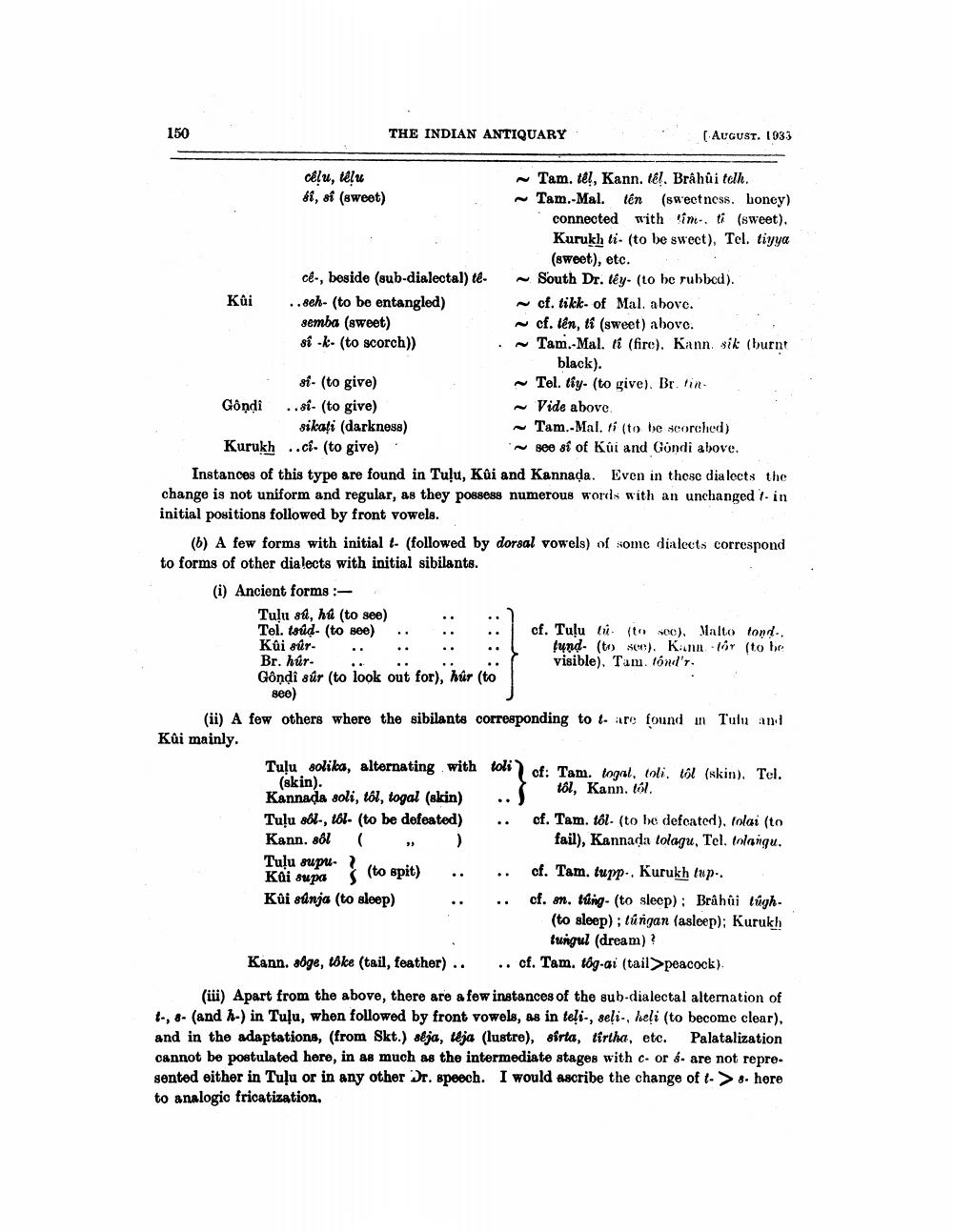________________
150
THE INDIAN ANTIQUARY
(AUGUST. 1033
célu, telu
Tam, tel, Kann, tel. Brâhủi telk. fi, si (sweet)
Tam.-Mal, tên (sweetness. Loney)
connected with sim.. ti (sweet). Kurukh ti. (to be sweet), Tel. tiyya
(sweet), etc. cé-, beside (sub-dialectal) te- South Dr. téy. (to be rubbed). Kui ..seh- (to be entangled)
cf. tikk- of Mal. above. semba (sweet)
ở ct. tên, tố (sweet) above. sí -- (to scorch)
. Tam - Mal. ti (fire), Kann sik (burnt
black). 81. (to give)
Tel. tiy (to give). Br. lin. Gôndi ..si- (to give)
Vide above sikați (darkness)
Tam.-Malti (to be scorched) Kurukh ..ci. (to give)
see sî of Kúi and Gondi above. Instances of this type are found in Tuļu, Kúi and Kannada. Even in these dialects the change is not uniform and regular, as they possess numerous words with an unchanged - in initial positions followed by front vowels.
(6) A few forms with initial t- (followed by dorsal vowels) of some dialects correspond to forms of other dialects with initial sibilants. (i) Ancient forms
Tuļu 81, ha (to see) Tel. Isúd- (to see) ..
cf. Tuļu tu (to soc), Malto tond.. Kui sur.
tund. (to sco), Kiinn fór (to be Br. húr.
visible). Tam, tond's. Gôndi sûr (to look out for), húr (to
seo) (ii) A few others where the sibilants corresponding to t re found in Tulu ani Kui mainly.
Tulu solika, alternating with toli cf: Tam. togral, toli. tól (skin). Tel. (skin).
tôl, Kann. tól. Kannada soli, tôl, togal (skin) Tuļu sól-, tól. (to be defeated)
cf. Tam. tôl. (to be defcated), folai (to Kann. 8ôl (
fail), Kannada tolagu, Tel. Inlangu. Tuļu supu.
cf. Tam. tupp. Kurukh tup.. Kui sdnja (to sleep)
.. cf. 8m, tàng- (to sleep): Brahi tigh
(to sleep); lúngan (asleep); Kurukh
tungul (dream)? Kann soge, toke (tail, feather) .. .. cf. Tam, tôg-ai (tail>peacock). (iii) Apart from the above, there are a few instances of the sub-dialectal alternation of 1., 8. (and h-) in Tulu, when followed by front vowels, as in teļi-, seli., heli (to become clear), and in the adaptations, (from Skt.) sēja, tēja (lustre), sirta, tirtha, etc. Palatalization cannot be postulated here, in as much as the intermediate stages with c. or . are not represented either in Tuļu or in any other Dr. speech. I would ascribe the change of t-> 8. here to analogic fricatization.
Kai supa
(to spit)




